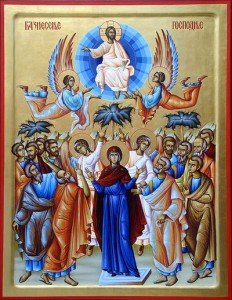TOPIC: Synoptic Gospels
By Len Mier
A Sermon
THE TRANSFIGURATION OF CHRIST IN MATTHEW’s GOSPEL

Every year the Church celebrates this great feast of the Transfiguration of Christ, one of the twelve great feasts of Our Church. A feast that reveals to us something about our own salvation, we are presented with the transfiguration account as told in St. Matthew’s Gospel.
I find it not to be overlook that Matthew begins with the phrase, “After six days Jesus took Peter, James and John his brother, and led them up a high mountain by themselves.” What happened six days prior? Matthew seems to want us to be aware of a specific frame of time. Numbers played a role in Jewish understanding of the cosmos. Why is it important that Matthew tells us six days passed? What does this miraculous event mean for us in our lives?
We have to look back to the previous chapter of Matthew’s gospel to find our why this mention of six days is important to the telling of the transfiguration account and why it is important to our own understanding about Jesus. Let us look back in the gospel of Matthew to hear Jesus asking the twelve a question that Christians still ask themselves today: “Who do people say that the Son of Man is?” We need to remind ourselves that Matthew was writing to an audience that was primarily of Jewish origin. For them the term “Son of Man” had messianic overtones. For them the messiah was to be a person who restored the earthly kingdom of the people of Israel. The answers varied from the twelve. So Jesus probes His disciples further. Having lived with them and taught them in word and deed, Jesus goes on to ask them more specifically: “But who do you say that I am?” to which Peter gives his confession “You are the Messiah, the Son of the living God.”
As if starting a timer Matthew starts counting. Where else do we encounter this time frame? It is the same time frame as the writer of the creation narrative in the Book of Genesis. One the first day of creation, we hear the revelation that God makes His presence known to this world He is creating by showing His presence with that of light, “Let there be light, and there was light.” This idea of six days of creation I think spoke to the mind of the early Jewish followers of Christ. A great revelation of light is God’s presence made manifest. We see the creation narrative moving in time through to the sixth day. The last day of creation ius the summit of all that God wanted to create. This first creation ends with “Let us make human beings in our image, after our likeness.”
Peter saying, “You are the Messiah” about Jesus is as great a revelation to the other disciples who were probably expecting the Messiah to be the warrior king, giving Divine order and displacing the chaos of their world, just as the creative revelation of God’s divine light displaced the darkness of chaos. They start to realize at this moment that Jesus was not the warrior political kingdom restorer Messiah mainstream Judaism of the day wanted. We see that Matthew now progresses full force toward this event of the transfiguration. All the gospel accounts take Peter, who made the profound confession, along with James and his brother John, to this event. It is here on the height of creation that this miraculous event takes place.
Matthew tells us Jesus was transfigured before them and that appearing with Him are Moses, the first law giver, and Elisha, the greatest of Israel’s prophets. The evangelist tells us Jesus’ face shone like the sun and His clothes became white as light, and we hear the voice of the Father reaffirming Peter’s confession to the three, “This is my beloved Son.” Our icon of this great feasts gives us a glimpse of what this event looks like to the believer. If we compare it to the icon of the Lord’s resurrection we can see that the transfigured Jesus is depicted with the same glorious mandorla, the uncreated eternal light of the resurrected Christ.
Is Matthew trying to tell us that this transfiguration happening six days past proclamation by Peter, that Jesus is the Messiah, the culmination of a new creation in Christ? Yes, I think Matthew is revealing to us a completion of the new creation, the fact that Jesus is the perfection of creation and that the resurrected Jesus will be the first born of this new creation.
Now comes the difficulty with reading about this miraculous event, what does this miraculous event mean for us in our lives?
In order for this passage of scripture to be relevant to a modern Eastern Christian we have to go beyond basking in the glow of light from the miracles of the manifestation of Jesus on the mountain. I think that we must take away from the account of the transfiguration, that in baptism we too have become a new creation, if we truly take on Christ. His presence with Moses, the first law giver, He is also a new law giver. Giving us the law, “Love one another as I have loved you.” His presence with Elijah, He is also the new and greatest of prophets, in that He shows to us truly what God’s will is. In accepting this new creation for ourselves we need to see that the spark of Divine light is within us., We need to nurture and grow this Divine light dwelling within us, until it busts forth from us. We need to make manifest this Divine light for not only those close to us to see but make it shine for the whole world to see in us.
***************
This weekend we are all called to think about the meaning that this great feast has for us. The feasts of our Church are meant to help us gain great insights into the meaning of our human lives. Although they may focus on Jesus or Mary, they are integrated into our religious life as a means of helping us gain greater insights into this earthly existence. We must always remember that Jesus, Mary and those who followed Jesus, reveal by their lives something very important about human life itself. So we should not get “stuck” in just thinking about the story of the feast but, rather, think about what it reveals to us about our own lives. Our religion is meant to help us live our present life in a manner that truly helps us to spiritually grow.
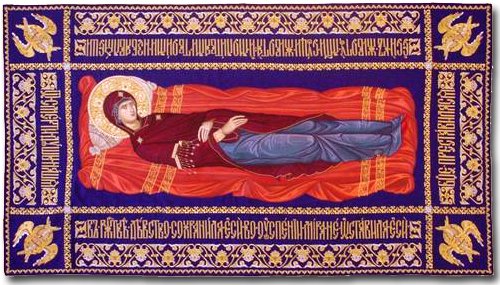 During this coming week our Church will celebrate one of the 12 major feasts of our Church, namely the “Dormition of the Mother of God.” We will also celebrate it, since it is within the octave of the feast, next weekend as a community.
During this coming week our Church will celebrate one of the 12 major feasts of our Church, namely the “Dormition of the Mother of God.” We will also celebrate it, since it is within the octave of the feast, next weekend as a community.
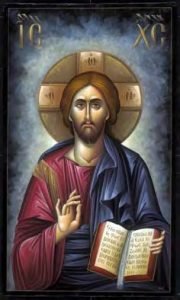 realize that this article becomes, at times, very technical. What I am trying to present is the idea that the books we now see as a part of the New Testament (NT) were only gradually chosen from a number of writings that were extant in the early Church. We have seen that by 200 CE the Gospels, the Pauline epistles, Acts, 1 Peter and 1 John had come into general acceptance; and that by the end of the 4th century in the Latin and Greek Churches there was general acceptance of the 27-book canon of the NT. However, this development cloaks some difficulties that should be understood.
realize that this article becomes, at times, very technical. What I am trying to present is the idea that the books we now see as a part of the New Testament (NT) were only gradually chosen from a number of writings that were extant in the early Church. We have seen that by 200 CE the Gospels, the Pauline epistles, Acts, 1 Peter and 1 John had come into general acceptance; and that by the end of the 4th century in the Latin and Greek Churches there was general acceptance of the 27-book canon of the NT. However, this development cloaks some difficulties that should be understood.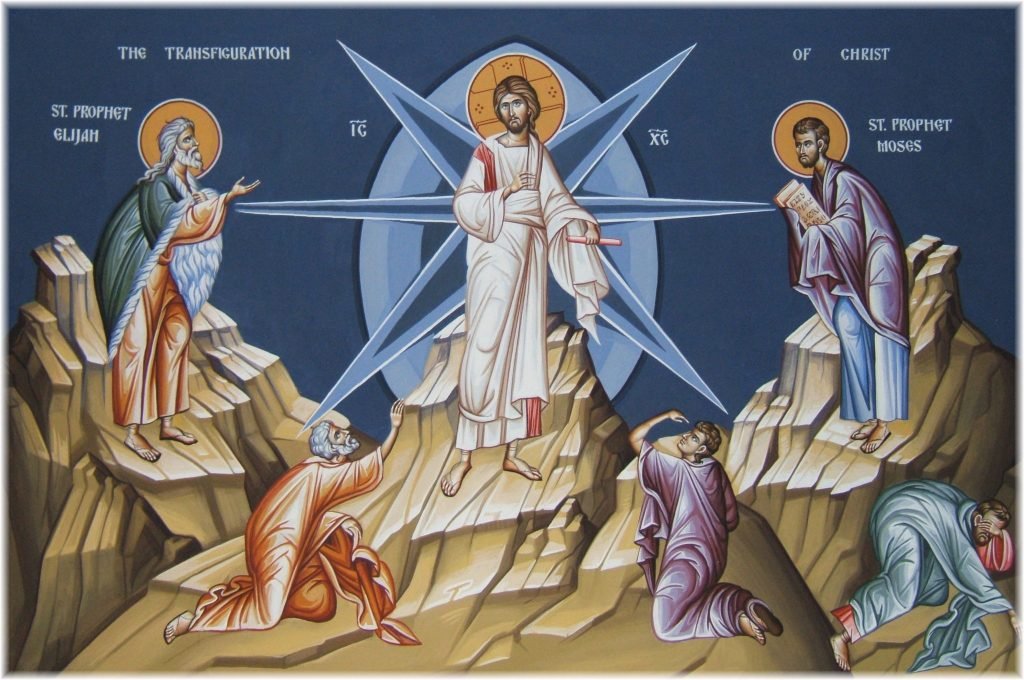 This year the feast of the Transfiguration of Our Lord falls on the ninth weekend after Pentecost. Because it is one of the major feasts of Our Lord, our proper prayers are taken totally from the feast. Our first reading is taken from St. Peter’s second letter. Peter includes this very powerful statement in his letter:
This year the feast of the Transfiguration of Our Lord falls on the ninth weekend after Pentecost. Because it is one of the major feasts of Our Lord, our proper prayers are taken totally from the feast. Our first reading is taken from St. Peter’s second letter. Peter includes this very powerful statement in his letter: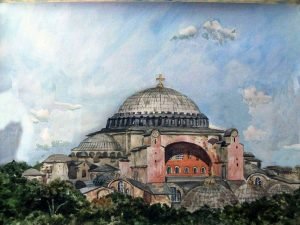 The observance of this feast goes back to the fourth century. At that time, St. Helena, mother of Emperor Constantine the Great, built a church on Mt. Tabor in honor of the Lord’s Transfiguration. At the end of the eleventh century, the Crusaders found several churches and monasteries on Mt. Tabor. In the thirteenth century, however, the Mohammedans came and destroyed them. Cyril II, the Patriarch of Jerusalem, built a new church over the ruins of the ancient church in 1860. In 1923, a magnificent basilica in honor of the Transfiguration of our Lord was built on Mt. Tabor.
The observance of this feast goes back to the fourth century. At that time, St. Helena, mother of Emperor Constantine the Great, built a church on Mt. Tabor in honor of the Lord’s Transfiguration. At the end of the eleventh century, the Crusaders found several churches and monasteries on Mt. Tabor. In the thirteenth century, however, the Mohammedans came and destroyed them. Cyril II, the Patriarch of Jerusalem, built a new church over the ruins of the ancient church in 1860. In 1923, a magnificent basilica in honor of the Transfiguration of our Lord was built on Mt. Tabor.
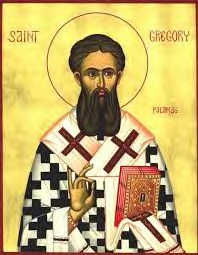 Gregory asks: What if the difference between the Father and the Son, between the unbegotten and the begotten, “is outside the essence”? On a human level, for instance, I can be a father within certain relationships, but my fatherhood is not part of the essence of what it means to be a human being. If it were, as Gregory observes, I would end up being my father’s father, since I would be “the same with him in essence.” Gregory comments that in order to investigate the “nature of the essence of God” might leave issues concerning personality or individuality “absolutely unaffected.” We perhaps are on the right track here, particularly because if we describe God’s nature itself as begotten and unbegotten, we end up with “contradictory essences, which is impossible.
Gregory asks: What if the difference between the Father and the Son, between the unbegotten and the begotten, “is outside the essence”? On a human level, for instance, I can be a father within certain relationships, but my fatherhood is not part of the essence of what it means to be a human being. If it were, as Gregory observes, I would end up being my father’s father, since I would be “the same with him in essence.” Gregory comments that in order to investigate the “nature of the essence of God” might leave issues concerning personality or individuality “absolutely unaffected.” We perhaps are on the right track here, particularly because if we describe God’s nature itself as begotten and unbegotten, we end up with “contradictory essences, which is impossible.